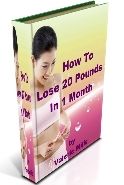Unfortunately, it's built into most processed foods.
It is
responsible for the following:
- Losing appetite control (so that we overeat).
- Creating an environment for major disease.
- Putting on unwanted pounds, especially around the waist.
- Feeding cancer cells.
Obesity is the result of consuming food laced with this ingredient and not because people overeat and don't exercise.
Yet we
keep eating and drinking it in large quantities.
Why? It
tastes good. We are used to it. We need it like a drug addict needs heroin or a
smoker craves nicotine. It's a bad habit that's difficult to break.
This is a
problem created a hundred years ago when food manufactures discovered that this
ingredient sells food. Consumers eat processed food. They lose control of their
appetite and don't realize they are overeating.
What
popular commercial boasts that ":You can't eat just one?" When's the
last time you mindlessly munched through a box of cookies or crackers or a
oversized bowl of ice cream.
We eat
19 times the daily amount of sugar that our ancestors consumed.
How Do
We Break This Bad Eating Habit?
First, many people need an incentive to change their eating habits. It may not be enough to say that sugar is a major health hazard (smokers still smoke even though they are committing suicide with each cigarette they light up). Listing all the problems that will likely show up at a future date will not incent some people.
First, many people need an incentive to change their eating habits. It may not be enough to say that sugar is a major health hazard (smokers still smoke even though they are committing suicide with each cigarette they light up). Listing all the problems that will likely show up at a future date will not incent some people.
If we
supply a substitute every time we identify a trigger for sugar eating, that's a
good start. That means we have to plan to make sugar substitutes (or foods with
lower sugar content) easily available.
Sugar
addiction will not disappear on its own. Gradual sugar reduction may be
the answer to turn appetite control back on. Essentially, you wean yourself off sugar. We cannot be so strict that we bypass
the occasional treat (especially if it's been prepared with less sugar than
usual).
An
example might help.
If you drink coffee or tea or lemonade with sugar, start cutting down the amount of sugar you use. I used to drink coffee with sugar. After a few weeks of eliminating sugar gradually, I got used to sugarless coffee. And a caution - do not substitute artificial sweeteners. Healthwise, that's even worse than using the real thing.
If you drink coffee or tea or lemonade with sugar, start cutting down the amount of sugar you use. I used to drink coffee with sugar. After a few weeks of eliminating sugar gradually, I got used to sugarless coffee. And a caution - do not substitute artificial sweeteners. Healthwise, that's even worse than using the real thing.
The
First Step
Keep a food diary.
Keep a food diary.
Jot down every food and drink you consume (except for water),
the amount you eat, and its sugar content. This is easy for processed foods
because the amounts are spelled out on package contents. It's somewhat trickier
for meals that include several ingredients. You will guesstimate the sugar
content. You can look up the sugar content of most individual items online.
The benefit of a food diary is that you will be aware of your daily sugar consumption. You will be surprised at the amount you do it and will start looking for substitutes. You will automatically cut back on sugar.
Double Your Weight Loss
Click HERE to view a video entitled Double Your Weight Loss with a Food Journal.
In the video, Barbara Ficarra, RN, explains how keeping a food journal can make a huge difference and help you reach your goals.



No comments:
Post a Comment